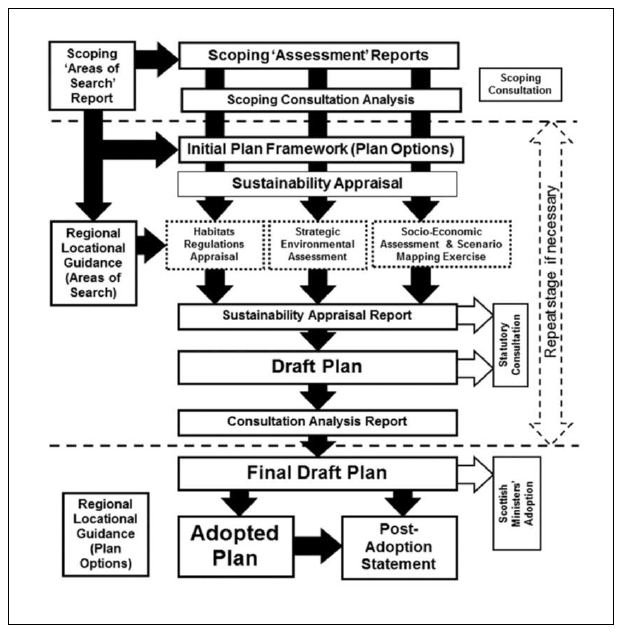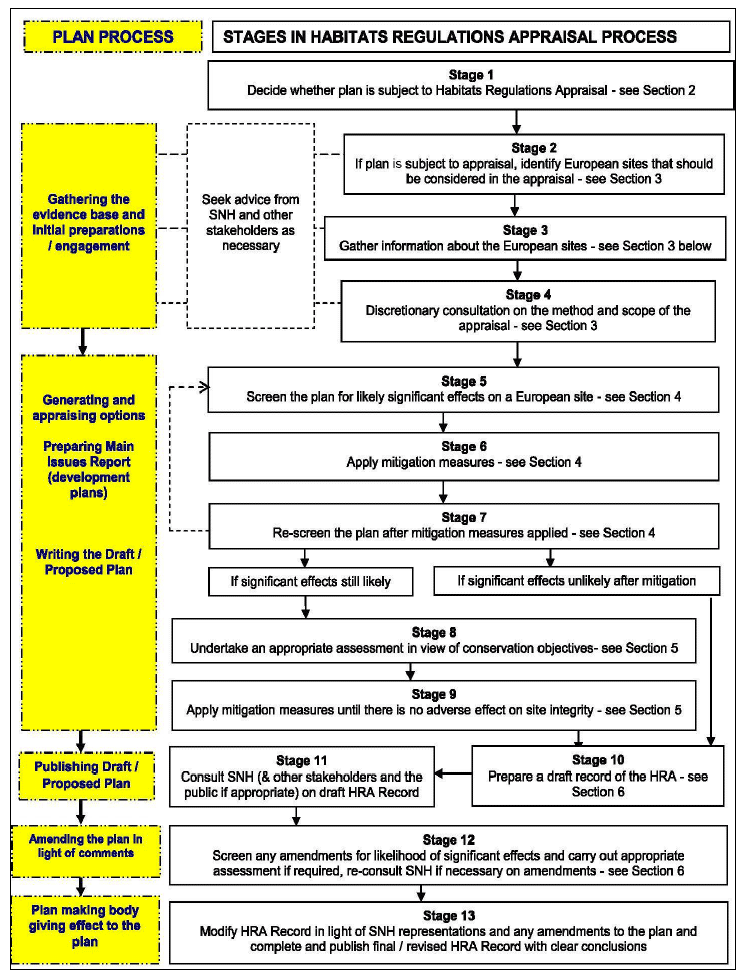Sectoral marine plan: appropriate assessment
Assessment of the implications of the sectoral marine plan for offshore wind energy for designated special areas of conservation special protection areas, candidate special areas of conservation and proposed special protection areas in view of the sites' conservation objectives.
3. Preparation of the HRA Report
3.1.1 The planning process commenced in 2017 and was conducted in accordance with the process shown in Figure 5. Further detail regarding the planning process can be found in the final Plan.

3.1.2 The HRA process for the Plan has followed the 13-step process set out in the agreed SNH guidance for undertaking plan-level HRA in Scotland and as set out in the Pre-Screening HRA Report[2] and as shown in Figure 6.

3.1.3 The 13 step process has been adopted, and consulted upon, over three key project phases to ensure there is clarity and a clear audit trail in the assessment process (an important requirement for strategic-level HRAs, which need to be carried out in an iterative, transparent and auditable manner). The HRA and this Appropriate Assessment have been undertaken in accordance with guidance provided by SNH on HRA of Plans.[3] This process also takes into the guidance produced by the European Commission on the "Assessment of plans and projects significantly affecting Natura 2000 sites".[4]
3.1.4 The HRA process for the draft Plan was overseen by a Plan Steering Group which included representatives of the Scottish Government, Scottish Natural Heritage, Joint Nature Conservation Committee ("JNCC"), Royal Society for Protection of Birds (Scotland) ("RSPB (Scotland))", Historic Environment Scotland, Marine Scotland Science ("MSS"), Regional Inshore Fisheries Groups, Scottish Environmental Protection Agency, Scottish Fishermen's Federation, Scottish Renewables, World Wildlife Fund and Crown Estate Scotland ("CES"). This ensured that the planning process met the requirements of these bodies and therefore the Appropriate Assessment Information Report incorporated the consultation and revision requirements of stages 11 - 13 of the HRA process.
3.1.5 Public consultation was undertaken on the scoping reports (including the HRA Pre-Screening Report) between 13 June 2018 and 18 July 2018. The Consultation Analysis Report is available, which summarises the outputs of this scoping consultation phase and further consultation undertaken post-scoping (e.g. July 2018 to June 2019). [5] The findings from the three phases are presented in the reports set out in Table 4.
Table 4 HRA Report - 3 Phase Reports
Phase: 1
HRA Stage(s): 1-3
Document and details:
Pre-Screening Report (June 2018)
Sets out the evidence base and proposed methods to be applied for the subsequent screening/scoping and assessment stages.
Phase: 2
HRA Stage(s): 4
Document and details:
Review of proposed Assessment Methodology (November 2018)
Produced following consultation on the pre-screening report. Considered the responses received and revisited the proposed HRA scoping and assessment methods in light of feedback and recent case-law developments.
This document was discussed with the Steering Group on 9 November 2018, generally positive feedback was received and it was agreed that the methods proposed in the Phase 1 report would be applied with minor changes (as set out in the Phase 2 report).
Phase: 3
HRA Stage(s): 5-10
Document and details:
Screening and Appropriate Assessment Information Report ("HRA Report") (December 2019)
Produced rationalised screening list, reflected case-law developments, impact pathways review, identification of features which are sensitive, activity-based screening of European/Ramsar sites, detailed pathway-feature sensitivity review and assessment of potential effects on European/Ramsar sites.
Contact
There is a problem
Thanks for your feedback